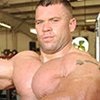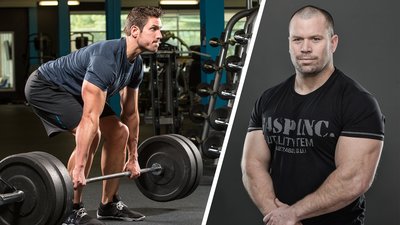Q: I've been doing sets of 8 deadlift reps at 315 pounds using the "bounce" style. An older powerlifter told me to stop between each rep, and now I can only do 3 reps. Which style should I use to prepare for my first powerlifting meet?
Think about squats and bench presses: Both exercises start with the weight at the beginning of the range of motion, and then you lower it. During this eccentric phase, your muscles store elastic-like energy that, if you choose to use it, can make it easier for you to return the weight to the starting position.
But does "easier" necessarily mean "better"?
To gain the most from your deadlifts, you need to stop at the bottom of the lift to get rid of that built-up energy. Do that, and your upward motion comes from muscle, not momentum. The same principle is at work when you bounce the bar off the floor at the bottom of a deadlift.

Train muscle, not momentum
A recent study concluded that the bounce technique does not allow the athlete to develop maximum force production in the early portion of the deadlift.[1] When you bounce, you take advantage of energy that has been stored up in your muscles to help you lift the bar up again to prepare for the next rep.
By taking advantage of this stored energy, you should, of course, be able to do more bounce reps than regular reps. This makes bouncing an easier technique—but not necessarily a better one. When you perform deadlifts this way, you're essentially training a different lift than you'll perform in a powerlifting meet. When you're starting out as a powerlifter, you need to focus on consistently executing the deadlift with the same technique you'll use in competition. This is sports-specific training 101.
Train for the event, not for ease
The first deadlift rep you do has no eccentric phase: Your first action is to lift the bar up off the floor. This means the lift starts in what is, mechanically speaking, the most difficult position. The eccentric phase doesn't come in until the second rep. At this point, your muscles have a chance to store energy as you lower the weight to the floor.

When you bounce a deadlift off the floor—or do a touch-and-go—you're creating a component of upward momentum that makes it easier to lift the weight. This technique completely changes the deadlift. While there are benefits to performing touch-and-gos for bodybuilders and advanced powerlifters alike, bouncing is rarely a good idea. For you and every other beginning and intermediate lifter, coming to a dead stop at the bottom of each lift is the correct way to train.
Staying tight and being properly braced is important for properly executing any powerlift. This is especially true for dead-stop deadlifts, because there is no elastic-like energy from the eccentric to help you back up. Lose tightness and you leak tension. As a result, you won't be able to lift as much weight.
Powerlifting is a single-rep sport
Start your deadlift training by considering every rep as a single rep. If your workout includes 3 deadlift reps, do them as 3 single reps, not as a set of 3. Take time to properly execute each rep. Doing so builds the strength and skill to increase your one-repetition deadlift maximum, which gets your ass ready for the powerlifting platform. Powerlifting is a one-rep sport, so start treating deadlifts accordingly. Stop bouncing and start stopping. Bouncing is the path of least resistance and, in this case, the path of least gains, as well.
References
1. Krajewski, K., LeFavi, R., & Riemann, B. (2018). A Biomechanical Analysis of the Effects of Bouncing the Barbell in the Conventional Deadlift. Journal of Strength and Conditioning Research.

